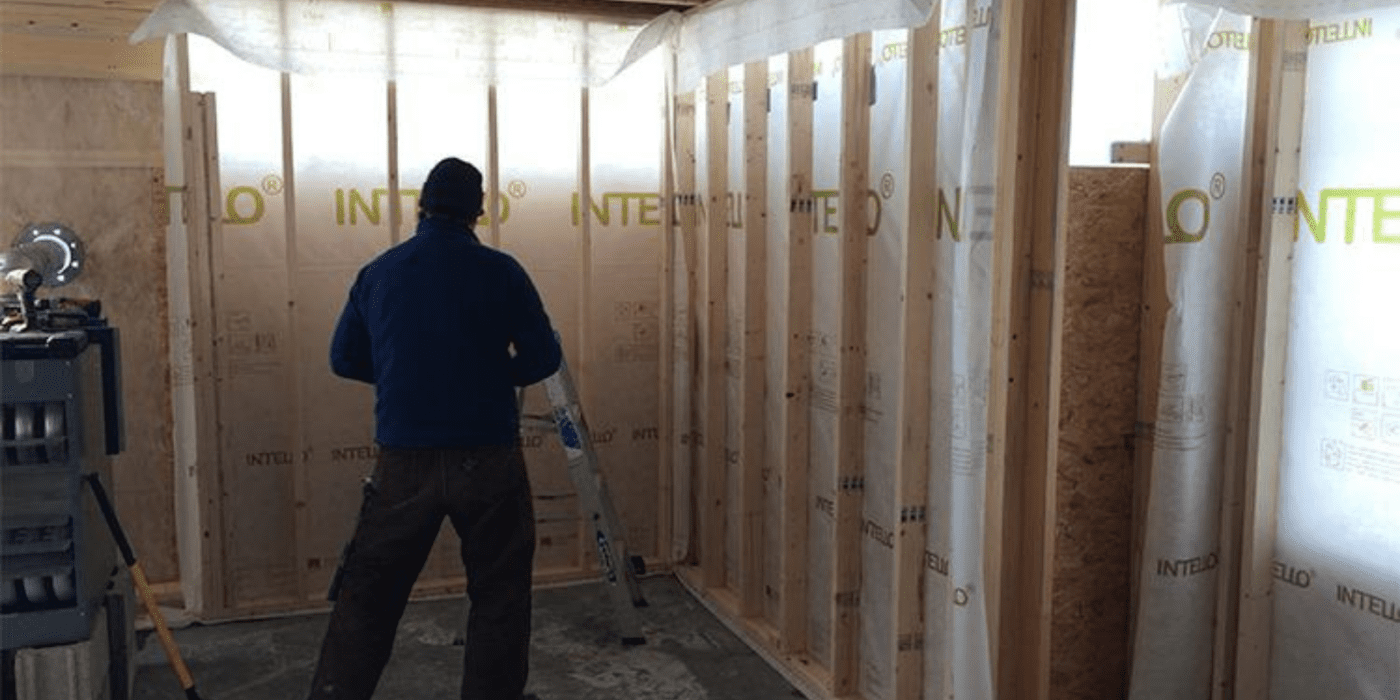Simplify
The double-stud wall is a well-established method for creating a very economical, durable, and high R-value assembly in new construction – and is one reason it’s included as one of the basic 475 Smart Enclosure System assembly types. We know pushing standard code-minimum construction toward high performance is complicated. So we’re always looking for ways to simplify – to simultaneously reduce cost while optimizing efficiency and occupant comfort. Integrated with Pro Clima air sealing and moisture control components, the double-stud wall provides unmatched economic value, safety from moisture damage, and long-lasting performance.
Go Sheathingless
With Pro Clima component integration, we’re taking it one step further. Below we illustrate a sheathingless double-stud wall (that’s right: no structural sheathing) that provides the following characteristics:
- Minimized material costs
- Maximized moisture drying potential
- Removal of formaldehyde, VOC’s and other toxic chemicals commonly found in SPF, rigid foams, OSB, and plywood
- Easily adjustable wall thickness to meet your design R-value
- Space between walls for continuous insulation
- Utilization of dense-pack insulation (Gutex wood THERMOFIBER, cellulose, fiberglass, mineral wool, or Havelock Wool).
- No special materials or connections needed for the framing components
- Fits with the typical platform framing method
You can still frame your walls on the deck and raise them into place, but without all that sheathing they’ll be a lot lighter. With this system, you build a house out of 2x4s, fibrous insulation, SOLITEX MENTO Plus weather-resistive barrier outboard, INTELLO Plus smart vapor retarder inboard, and not much else.
The Framing
The wall consists of an inner load-bearing wall and an outer exterior finishing wall. The floor and roof loads are stacked on top of the inner wall studs. This method can allow the use 24″ o.c. advanced framing assembly if your floor and roof loads meet the design criteria. The inner wall is framed like any other stick-built wall, with the exception that the shear load is carried by 2x lumber nailed, or metal strapping mechanically fastened, diagonally, to the outside face of the inner stud wall – in the insulation cavity.
It’s important to note that each structure will have very different shear and uplift retention requirements due to variables in building height, the number of windows, local codes, shape of building, seismic requirements, etc. The outer wall is connected to the decks as outriggers, there to support the insulation and finished facade elements, and consequently, it requires minimal framing material and opening headers. In taller walls, it’s important to connect the inner and outer studs for additional strength as well as partition the bays every second bay – to make dense-packing of the double stud cavities easier to reach proper density and maintain quality control.
The Integrated Service Cavity
With this approach, the inner wall studs act as the service cavity without the need for additional strapping to support the interior finish – making it an integrated service cavity. This approach takes planning but allows for fewer steps and less material. An excellent example of this approach is demonstrated in our Project Spotlight: Vermont Integrated Architecture. Leicester, VT.
Two Air Barriers Too
To optimize the insulating value of the dense-pack insulation – airtight membranes are placed on both sides of the fibrous insulation, thereby preventing thermal bypass, as well as optimizing the drying reserves of this highly insulated wall. At the interior side is the INTELLO PLUS membrane, airtight with intelligent vapor control, making it vapor open in the summer to facilitate inward drying and vapor retarding in the winter to prevent vapor accumulation into the insulation. The INTELLO Plus is reinforced so that it substitutes for the typical mesh used in a dense-pack installation. At the exterior side is SOLITEX MENTO PLUS: airtight, waterproof, reinforced and vapor open, allowing for maximum drying potential to the outside without being restricted by an exterior sheathing, like plywood or OSB, which are Class II or low Class III vapor retarders.
Windows & Penetrations
The window is installed into a plywood box that ties together the inner and outer walls. We offer a wide selection of window air sealing tapes, but to keep it simple you need only TESCON PROFIL, or the even faster TESCON PROFECT, for the airtight connections at the interior and exterior of the window. (And don’t forget to pre-make your window corners!). At the sill heavy-duty self-sealing waterproofing is provided by EXTOSEAL ENCORS. There are multiple ways to create a thermal bridge free window installation – there are many variables depending on the window type and brand.
The most important thing is to make sure that the window is precisely connected to your interior and exterior airtight and moisture control layers. This will ensure that your installation will not have condensation due to air movement at this thermally weak intersection. Small air leakage at this connection will allow the interior winter humidity to enter the insulated cavity. Making an air-tight connection at all openings is the best way to prevent future structural damage.
Learn More
For more details and variations on this concept, download 475’s free CAD details and ebook for 475 Smart Enclosure Double-Stud Assemblies.
By 475 Building Supply
This guest blog was originally published on the 475 Building Supply blog.



